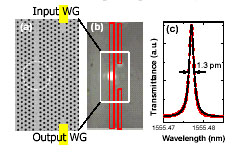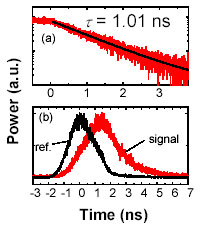Takasumi Tanabe, Eiichi Kuramochi, Akihiko Shinya,
Hideaki Taniyama, and Masaya Notomi
Optical Science Laboratory
A high-Q photonic crystal (PhC) nanocavity is very effective for application to
all-optical switches that can operate at an ultra-low energy [1], because
it can realize a high photon density at an extremely low input power.
It is known that an ultra-high-Q can be achieved with a PhC nanocavity by employing the local width modulation
of line defects [2]. A scanning electron microscope image of such a nanocavity
is shown in Fig. 1 (a). Although it is difficult to recognize, the
width of the line defect is slightly modulated in the circled region.
As a result, a mode-gap cavity forms in this area. Indeed, the far-field
pattern shows that the light is localized when the wavelength of the input
light is same as the resonance of the cavity [Fig.1(b)]. Figure 1(c)
shows the transmittance spectrum measured using a wavelength tunable laser.
The transmittance width is an extremely small 1.3 pm, which corresponds
to a Q of 1.2 million. To achieve higher wavelength resolution, we applied
a single side band modulator to sweep the frequency of the laser light
with an ultra-high accuracy. We obtained the same Q value and confirmed the accuracy of the measurement [3].
In contrast, since an ultra-high Q
cavity system has a long photon lifetime, the Q can be directly obtained in the time domain. In addition, time resolved
measurement is a powerful way to characterize the dynamic behavior of the
cavity system. Therefore, we combined ring-down measurement with
time correlated single photon counting to obtain the optical property of
the PhC cavity in the time domain [4]. First, a rectangular pulse
is employed as the input, and it is suddenly turned off at 0 ns.
Then the photons that where trapped in the cavity start to decay through
the output waveguide. By observing the discharging signal using time
resolved measurement we obtained a photon lifetime of 1.01 ns [Fig. 2(a)].
The accuracy and the reproducibility of time domain measurement were confirmed
[5] and the photon lifetime agrees perfectly with that obtained with spectral
domain measurement.
Finally we studied the propagation of a pulse through the cavity system
by using time resolved measurement. We obtained a pulse delay of
1.45 ns for an input pulse with a width of 1.9 ns [Fig. 2(b)]. This
value corresponds to the record smallest group velocity of 5.8 km/s demonstrated
in any dielectric slow-light material. The above result paves the
way for the application of the enhancement of light and matter interaction
or the development of an optical delay line with a small footprint.
[1] T. Tanabe, et al., Appl. Phys. Lett. 90 (2007) 031115.
[2] E. Kuramochi, et al., Appl. Phys. Lett. 88 (2006) 041112.
[3] T. Tanabe, et al., Electron. Lett. 43 (2007) 187.
[4] T. Tanabe, et al., Nat. Photonics 1 (2007) 49.
[5] T. Tanabe, et al., Opt. Express 15 (2007) 7816.
 |
 |
|||||
|
|